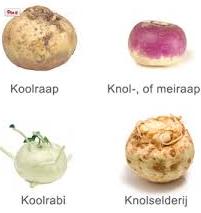Turnip, rutabaga, turnip, cabbage and kohlrabi are similar, the words too, and often the same names are used for different field fruits. The scientific name is mostly more correct. But if you look them up, you often find for the same name different descriptions and completely different pictures.
 Of turnip (Brassica rapa), you can cook the leaves like spinach. The usually white tubers are smaller than kohlrabi. Young leaves are called turnip greens (or puree leaves). It is a spring vegetable. The tubers are brushed, possibly peeled and cooked, fryed or used in salads. Turnip was used much before the arrival of the potato, now still little. He can from April be sown on spot, it grows very quickly and can be harvested after 6 weeks.
Of turnip (Brassica rapa), you can cook the leaves like spinach. The usually white tubers are smaller than kohlrabi. Young leaves are called turnip greens (or puree leaves). It is a spring vegetable. The tubers are brushed, possibly peeled and cooked, fryed or used in salads. Turnip was used much before the arrival of the potato, now still little. He can from April be sown on spot, it grows very quickly and can be harvested after 6 weeks.
Kohlrabi is probably a cross between cabbage (Brassica oleracea) and turnip (Brassica rapa). They look very similar, and are often known by the same name.
Typical differences:
weight - the rutabaga can each be one kilogram, turnips are smaller;
color - the rutabaga as vegetable sold is orange-yellow inside with a rough green yellow skin, most turnips are white, (but not always!)
growth - the Kohlrabi is formed as top of the taproot, the turnip has also contiguous thickened stem base;
cultivation: rutabaga can be replanted, picked out;
season - the rutabaga can withstand cold and is a typical winter vegetable, the turnip is an early vegetables.
In knoll kohl (or kohlrabi, Brassica oleracea var.Gongylodes) is the thickened stem above the ground. In swede (turnip) underground.
The young leaves of rutabaga (Brassica napobrassica, cabbage family) is "cutting vegetable' or 'cutting cabbage' and is also eaten. Kohlrabi has a rounded root on top of which the central leaves stand together.
The tubers can be stored at 1°C up to six months for human and animal. The tubers are peeled and cut into sticks, eaten cooked or stewed. They have a sweet flavor.
The turnip was formerly (from June) mostly in August sown after the harvest and fresh from October to December conducted to cattle. They were eaten raw, as an apple and in salads.
Rapeseed produced grease: the main inland oil for consumption and lighting.
As fodder they were also tastable in butter, this "autumn butter' was much appreciated. They can also be ensilaged.
Varieties without tuber are now sown as green manure.
Kohlrabi (Brassica oleracea L. gongylodes cruciferae) is related to cauliflower and so is a cabbage, not a turnip. The tuber is a stem above the ground thickened into a flat round tuber on which the leaves are scattered implanted.
There are varieties of light green to purplish. (Also often called turnip cabbage. This, according to some sources, is a cross between wild cabbage and wild beet.)
(A rabbi is a Jewish rabbi or teacher.)
(When buying seed are kohlrabi, rutabaga, turnip, green manure,… often confused.)
Brassica rapa: rape and turnip, turnip greens also, or field mustard
Brassica rapa var. Majalis: turnip
Brassica rapa var. Napus: swede, rape
Brassica rapa subsp. Oleifera: rapeseed (oil)
Brassica rapa var. Rapa: turnip
Brassica rapa var. Rapifera: garden turnip
Brassica oleracea var. caulorapa, synonym: Brassica oleracea var. gongylodes: kohlrabi (often called turnip cabbage.)
Brassica nigra: black mustard
Brassica (rapa subsp.) Pekinensis: Chinese cabbage, celery cabbage
Brassica oleracea var. Botrytis: cauliflower
Brassica oleracea gemmifera Group: Brussels sprouts
